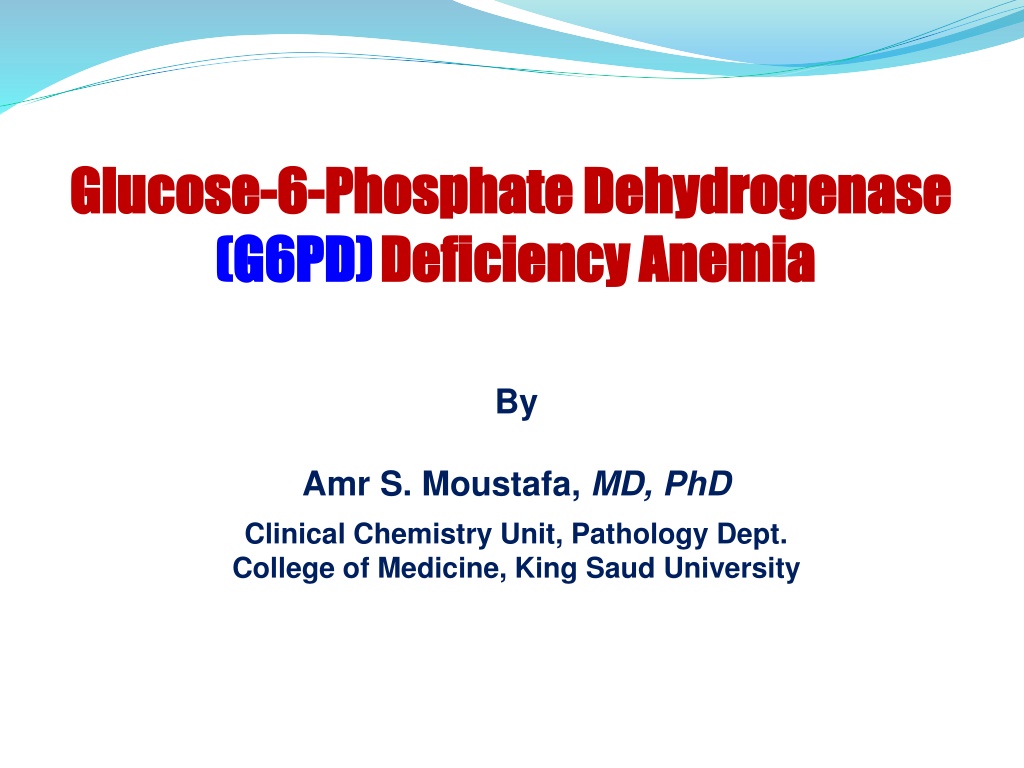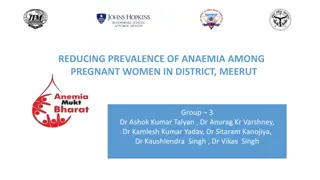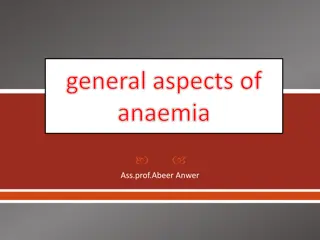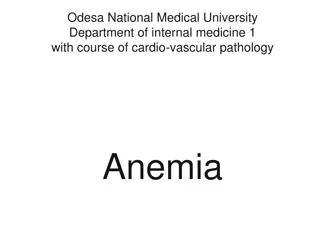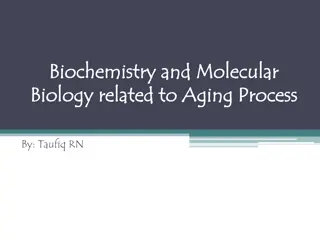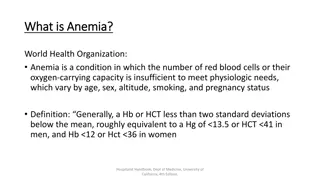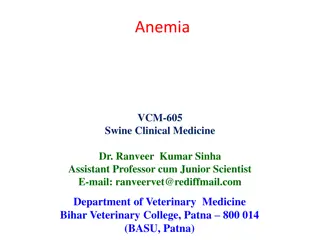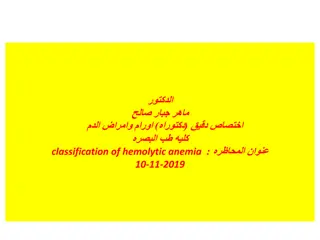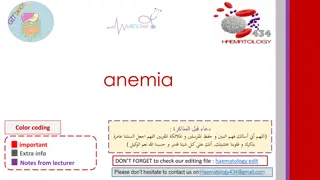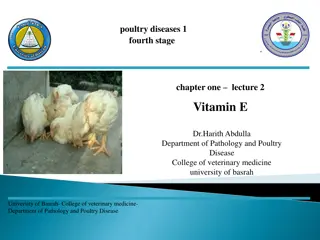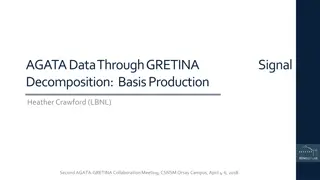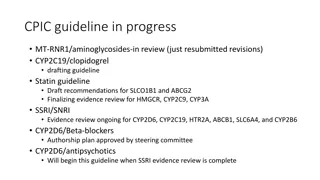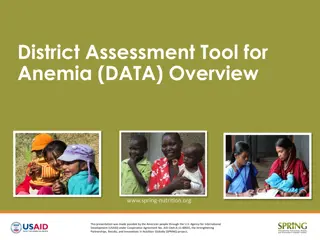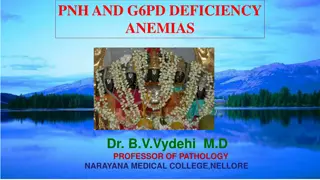Understanding G6PD Deficiency Hemolytic Anemia: Biochemical Basis and Implications
G6PD deficiency hemolytic anemia is an inherited condition characterized by reduced levels of glucose-6-phosphate dehydrogenase (G6PD), leading to impaired production of NADPH. This deficiency affects the Pentose Phosphate Pathway (PPP) and can result in oxidative stress, causing damage to DNA, proteins, and lipids. Learn about the biochemical basis, classes, diagnosis, and prevalence of G6PD deficiency anemia, along with the vital role of NADPH and antioxidant mechanisms in mitigating reactive oxygen species. Explore the implications of this condition on various populations and the significance of maintaining a balance between oxidant production and antioxidant mechanisms.
Download Presentation

Please find below an Image/Link to download the presentation.
The content on the website is provided AS IS for your information and personal use only. It may not be sold, licensed, or shared on other websites without obtaining consent from the author. Download presentation by click this link. If you encounter any issues during the download, it is possible that the publisher has removed the file from their server.
E N D
Presentation Transcript
Glucose Glucose- -6 6- -Phosphate Dehydrogenase Phosphate Dehydrogenase (G6PD) (G6PD)Deficiency Anemia Deficiency Anemia By Amr S. Moustafa, MD, PhD Clinical Chemistry Unit, Pathology Dept. College of Medicine, King Saud University
Objectives: The biochemical basis of G6PD deficiency anemia The precipitating factors for G6PD deficiency anemia Classes of G6PD deficiency anemia (variant enzyme) Diagnosis of G6PD deficiency anemia
Background Hexose monophosphate pathway (HMP) or Pentose Phosphate Pathway (PPP): An alternative oxidative pathway for glucose No ATP production Major pathway for NADPH production Produces ribose-5-phosphate for nucleotide synthesis
Pentose Phosphate Pathway (PPP) Glucose-6-phosphate dehydrogenase
Uses of NADPH Reductive biosynthesis e.g., fatty acid biosynthesis Antioxidant (part of glutathione system) Oxygen-dependent phagocytosis by WBCs Synthesis of nitric oxide (NO)
Reactive Oxygen Species (ROS) Oxygen-derived Free radicals :e.g., Superoxide and hydroxyl radicals Non-free radical: Hydrogen peroxide
Glutathione System Selinium
Oxidative Stress Imbalance between oxidant production and antioxidant mechanisms Oxidative damage to: DNA Proteins Lipids (unsaturated fatty acids) Oxidative stress and diseases: Inflammatory conditions e.g., Rheumatoid arthritis Athersclerosis and coronary heart diseases Obesity Cancers G6PD deficiency hemolytic anemia
G6PD Deficiency Hemolytic Anemia Inherited X-linked recessive disease Most common enzyme-related hemolytic anemia Highest prevalence: Middle East, Tropical Africa Asia and Mediterranean ~400 different mutations affect G6PD gene, but only some Can cause clinical hemolytic anemia G6PD deficient patients have increased resistance to Infestation by falciparum malaria
Biochemical Basis of G6PD Deficiency Hemolytic Anemia
Biochemical Basis of G6PD Deficiency Hemolytic Anemia Oxidation of sulfhydryl groups of proteins inside RBCs causes protein denaturation and formation of insoluble masses (Heinz bodies) that attach to RBCs membranes
Biochemical Basis of G6PD Deficiency Hemolytic Anemia CONT D Although G6PD deficiency affects all cells, it is most severe in RBCs Why? Other cells have other sources for NADPH production: e.g., Malic enzyme that converts malate into pyruvate
Precipitating Factors for G6PD Deficiency Hemolytic Anemia G6PD deficient patients will develop hemolytic attack upon: Intake of oxidant drugs (AAA): Antibiotics e.g., sulfa preparation Antimalarial: e.g., Primaquine Antipyretics Exposure to infection Ingestion of fava beans (favism, Mediterranean variant) Chronic nonspherocytic anemia: Hemolytic attack in absence of precipitating factors. Severe form due to class I mutation
Different Classes of G6PD Deficiency Hemolytic Anemia The severity of the anemia depends on the residual enzymatic activity More severe disease is associated with less enzymatic activity
Variant Enzymes of G6PD Deficiency Hemolytic Anemia G6PD A- (class III): Moderate, young RBCs Contain enzymatic activity Unstable enzyme, but Kinetically normal G6PD Mediterranean (II) Enzyme with normal stability but low activity (severe) Affect all RBCs (both young and old)
Diagnosis of G6PD Deficiency Hemolytic Anemia Diagnosis of hemolytic anemia CBC and reticulocytic count Screening: Qualitative assessment of G6PD enzymatic activity (UV-based test) Confirmatory test: Quantitative measurement of G6PD enzymatic activity Molecular test: Detection of G6PD gene mutation
